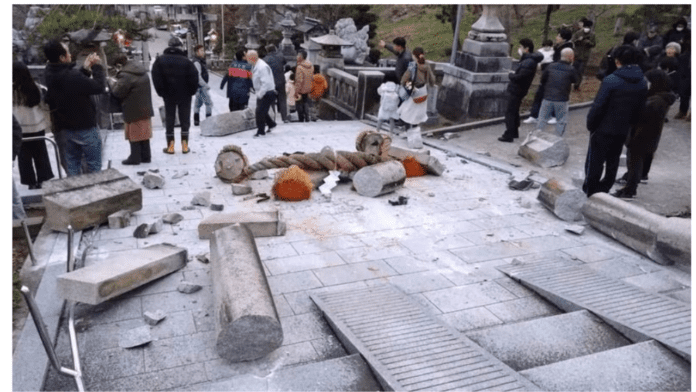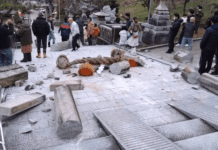After the 7.6-magnitude earthquake wreaked havoc on Japan this Monday, triggering a tsunami, various powerful tremors reverberated across the entire country.
As a result, thousands of residences had power outages, there were delays in air and train services, and the impacted communities were concerned.
The Japan Meteorological Agency reported that within just over 90 minutes, 21 earthquakes with a magnitude of 4.0 or higher occurred in and around the Ishikawa coast of central Japan. The most intense shock, registering 7.6 magnitude just after 4 p.m., marked the first significant tsunami warning since 2011 when the country experienced a massive 9.0 magnitude earthquake under the sea in northeastern Japan. A significant tsunami warning indicates the possibility of waves exceeding three meters.
An initial alert, later modified to a general tsunami advisory, resulted in the suspension of some train services, halting operations at power plants, and necessitating inspections of nuclear reactors by authorities. NHK, the national broadcaster, advised all residents to move to higher ground immediately.
Look at this damage in Japan. Terrible way to start 2024😓#japan #earthquake #tsunami
— Crime With Bobby (@crimewithbobby) January 1, 2024
pic.twitter.com/5wNQ3cBttH
Stronger earthquakes may happen in the next several days in locations where seismic activity has been occurring for more than three years, according to Toshihiro Shimoyama, a JMA official. Residents were cautioned by Prime Minister Fumio Kishida to be on the lookout for further possible calamities.
He urged, “Residents should stay alert for possible future earthquakes, and I appeal to people in areas at risk of a tsunami to evacuate promptly.”
With a magnitude of 7.6, the earthquake was the biggest to have struck the Noto Peninsula since records went back to 1885. It occurred during the public holiday on January 1, when millions traditionally visit temples to celebrate the New Year.
In Kanazawa, a popular tourist destination in Ishikawa, images showed torii gates shattered at the entrance of a temple, causing concern among worried worshippers. A video clip posted on the social media platform X depicted queues of collapsed wooden houses in the Noto tsunami-prone district. A resident in the video pleaded for help, stating, “This is the Noto tsunami zone. Please come assist us. My city is in a dire situation.”

While there were no immediate reports of major casualties, videos on broadcaster ANN showed houses collapsed in Wajima, nearly 300 kilometers north of Tokyo, after being hit by a tsunami wave of at least 1.2 meters.
Footage of fierce fires destroying numerous buildings across the city was shown on NTV. According to government’s spokesman Yoshimasa Hayashi, military personnel have been sent in to carry out rescue efforts as officials determine the full scope of the damage.
A warning of waves up to three meters high was issued by the Pacific Tsunami Warning Center for parts of Japan’s western coast, including Niigata. Russian officials issued a tsunami warning, speculating that waves would strike Sakhalin Island’s western shore.
In South Korea, the Meteorological Agency urged residents of some eastern coastal cities to monitor changes in sea levels. Warning of the possibility of a small tsunami, it advised residents in Gangwon Province to be cautious and move to higher places.
The Japan Meteorological Agency reported that following the initial strong tremors of the earthquake, additional shocks were felt in the Noto region. At 4:06 p.m., a 5.7 magnitude earthquake sparked the seismic activity. After then, there were earthquakes with a magnitude of 7.6 at 4:10 p.m., 6.1 at 4:18 p.m., 4.5 at 4:23 p.m., 4.6 at 4:29 p.m., and 4.8 at 4:32 p.m.
The U.S. Geological Survey reported an additional 6.2 magnitude earthquake shortly afterward.
Broadcasters moved to special programming in response to the significant earthquakes, advising impacted citizens to call for an immediate evacuation to higher ground. A presenter from broadcaster NHK said, ‘We understand that your homes, your belongings, everything is precious to you, but your life is more important. Run to higher ground as much as possible.’
Japan Railways announced the closure of several major highways around the earthquake’s epicenter, and Shinkansen bullet train services between Tokyo and the Noto region were also suspended. Japanese airlines ANA canceled flights to and from Toyama and Ishikawa airports, while Japan Airlines canceled most of its services in the Niigata and Ishikawa regions, with officials stating that Ishikawa’s airport is closed
The videos broadcast by NHK showed buildings collapsing in Ishikawa and the capital trembling with earthquake shocks. Hokuriku Electric Power reported power outages in more than 36,000 homes in Ishikawa and Toyama prefectures.
While there were no immediate reports of casualties, and no abnormalities were confirmed in nuclear energy facilities along the coastline, authorities assured that inspections are ongoing. Government spokesperson Yoshimasa Hayashi mentioned, ‘It has been confirmed that there are no abnormalities at the Shika Nuclear Power Plant [in Ishikawa] and other stations.’
Japan has strict construction regulations designed to ensure that buildings can withstand strong earthquakes, and it regularly conducts emergency drills for earthquakes. Approximately 18,500 individuals perished in the tsunami of 2011, a calamity that led to the meltdown of three reactors at the Fukushima nuclear plant. This was the greatest nuclear accident since Chernobyl in 1986 and the worst calamity to strike Japan since the war.
In March 2022, a 7.4 magnitude earthquake off the coast of Fukushima shook large areas in eastern Japan, causing damage and claiming three lives. In 1995, nearly 6,000 people were killed in the Great Hanshin Earthquake, which slammed western Japan and mostly affected the city of Kobe.
A century ago, the metropolis of Tokyo endured significant devastation from a powerful earthquake in 1923. The recent seismic event serves as a alert to Japan’s enduring seismic risks, highlighting the importance of readiness and quick responses in the face of natural calamities.


